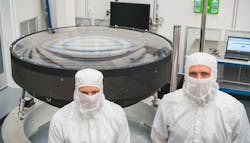LLNL ships world’s largest optical lens to SLAC for the LSST telescope
When the world’s newest telescope starts imaging the southern sky in 2023, it will take photos using optical assemblies designed by Lawrence Livermore National Laboratory (LLNL; Livermore, CA) researchers and built by Lab industrial partners.
A key feature of the camera’s optical assemblies for the Large Synoptic Survey Telescope (LSST), under construction in northern Chile, will be its three lenses, one of which at 1.57 m (5.1 ft) in diameter is believed to be the world’s largest high-performance optical lens ever fabricated.
The lens assembly, which includes the lens dubbed L-1, and its smaller companion lens (L-2), at 1.2 m in diameter, was built over the past five years by Boulder, CO-based Ball Aerospace and its subcontractor, Tucson, AZ-based Arizona Optical Systems.
Mounted together in a carbon fiber structure, the two lenses were shipped from Tucson, arriving intact after a 17-hour truck journey at the SLAC National Accelerator Laboratory in Menlo Park, CA.
SLAC is managing the overall design and fabrication, as well as the subcomponent integration and final assembly of LSST’s $168 million, 3200 Mpixel digital camera, which is more than 90% complete and due to be finished by early 2021. In addition to SLAC and LLNL, the team building the camera includes an international collaboration of universities and labs, including the Paris-based Centre National de la Recherche Scientifique and Brookhaven National Laboratory.
“The success of the fabrication of this unique optical assembly is a testament to LLNL’s world-leading expertise in large optics, built on decades of experience in the construction of the world’s largest and most powerful laser systems,” said physicist Scot Olivier, who helped manage Livermore’s involvement in the LSST project for more than a decade.
Olivier said without the dedicated and exceptional work of LLNL optical scientists Lynn Seppala and Brian Bauman and LLNL engineers Vincent Riot, Scott Winters and Justin Wolfe, spanning a period of nearly two decades, the LSST camera optics, including the world’s largest lens, would not be the reality they are today.
“Riot’s contributions to LSST also go far beyond the camera optics--as the current overall project manager for the LSST camera, Riot is a principal figure in the successful development of this major scientific instrument that is poised to revolutionize the field of astronomy,” Olivier added.
See the SOURCE link below to read the rest of the story …
SOURCE: LLNL; https://www.llnl.gov/news/world%E2%80%99s-largest-optical-lens-shipped-slac

Gail Overton | Senior Editor (2004-2020)
Gail has more than 30 years of engineering, marketing, product management, and editorial experience in the photonics and optical communications industry. Before joining the staff at Laser Focus World in 2004, she held many product management and product marketing roles in the fiber-optics industry, most notably at Hughes (El Segundo, CA), GTE Labs (Waltham, MA), Corning (Corning, NY), Photon Kinetics (Beaverton, OR), and Newport Corporation (Irvine, CA). During her marketing career, Gail published articles in WDM Solutions and Sensors magazine and traveled internationally to conduct product and sales training. Gail received her BS degree in physics, with an emphasis in optics, from San Diego State University in San Diego, CA in May 1986.
